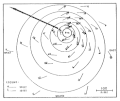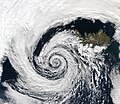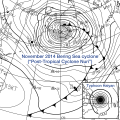Portal:Tropical cyclones
The Tropical Cyclones Portal
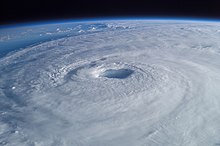
A tropical cyclone is a storm system characterized by a large low-pressure center, a closed low-level circulation and a spiral arrangement of numerous thunderstorms that produce strong winds and heavy rainfall. Tropical cyclones feed on the heat released when moist air rises, resulting in condensation of water vapor contained in the moist air. They are fueled by a different heat mechanism than other cyclonic windstorms such as Nor'easters, European windstorms and polar lows, leading to their classification as "warm core" storm systems. Most tropical cyclones originate in the doldrums, approximately ten degrees from the Equator.
The term "tropical" refers to both the geographic origin of these systems, which form almost exclusively in tropical regions of the globe, as well as to their formation in maritime tropical air masses. The term "cyclone" refers to such storms' cyclonic nature, with anticlockwise rotation in the Northern Hemisphere and clockwise rotation in the Southern Hemisphere. Depending on its location and intensity, a tropical cyclone may be referred to by names such as "hurricane", "typhoon", "tropical storm", "cyclonic storm", "tropical depression" or simply "cyclone".
Types of cyclone: 1. A "Typhoon" is a tropical cyclone located in the North-west Pacific Ocean which has the most cyclonic activity and storms occur year-round. 2. A "Hurricane" is also a tropical cyclone located at the North Atlantic Ocean or North-east Pacific Ocean which have an average storm activity and storms typically form between May 15 and November 30. 3. A "Cyclone" is a tropical cyclone that occurs in the South Pacific and Indian Oceans.
Selected named cyclone -
Typhoon Yagi, known in the Philippines as Severe Tropical Storm Enteng, was a deadly and extremely destructive tropical cyclone which impacted Southeast Asia and South China in early September 2024. Yagi, which means goat or the constellation of Capricornus in Japanese, was the eleventh named storm, the first violent typhoon of the season, and the first Category 5 storm of the annual typhoon season. It was one of the most intense typhoons ever to strike Northern Vietnam, the strongest typhoon to strike Hainan during the meteorological autumn, and the strongest since Rammasun in 2014. It is one of the four Category 5 super typhoons recorded in the South China Sea, alongside Pamela in 1954, Rammasun in 2014 and Rai in 2021.
Yagi originated from a low-pressure area that formed on August 30, approximately 540 km (330 mi) northwest of Palau. On September 1, the system was classified as a tropical storm and named Yagi by the Japan Meteorological Agency (JMA). After making landfall over Casiguran, Aurora, in the Philippines, on September 2, Yagi weakened as it moved inland through the rugged terrain of the Cordillera Central of Luzon. It later emerged over the South China Sea and began merging with a secondary circulation west of Lingayen Gulf, with its deep convection starting to wrap and develop convective bands extending west and south. On September 5, the JMA reported that the storm reached its peak intensity with ten-minute sustained winds of 195 km/h (120 mph) and a central pressure of 915 hPa (27.02 inHg). It subsequently peaked as a Category 5-equivalent super typhoon on the Saffir-Simpson scale, with one-minute sustained winds of 260 km/h (160 mph). After weakening during an eyewall replacement cycle, Yagi slightly restrengthened before making landfall near Wenchang in China's Hainan Province on September 6. Yagi passed over northern Hainan and directly over Haikou, before briefly making landfall over Xuwen County in mainland Guangdong Province and moving into the open waters of the Gulf of Tonkin. It made landfall over Haiphong and Quảng Ninh, Vietnam, on September 7 and moved southwestwards inland until it was last noted on September 8; however, its remnants later contributed to the formation of a deep depression over Bangladesh and India six days later. (Full article...)
Selected article -
In Honduras, Hurricane Mitch caused death and destruction across the entire country, resulting in the most significant flooding in Honduras in the 20th century. Hurricane Mitch, the strongest storm of the 1998 Atlantic hurricane season, formed on October 22, and after becoming a Category 5 hurricane, it weakened and struck Honduras on October 29. While near peak intensity, Mitch struck the offshore Guanaja island, where it nearly destroyed the mangrove forest. On the mainland, the hurricane dropped torrential rainfall, and many gauges were washed away in mountainous areas where unofficial rainfall totals were as high as 1900 mm (75 in). The highest official total was 928 mm (36.5 in) at Choluteca in southern Honduras, which was more than half of the annual precipitation average there. The rains caused widespread flooding and landslides, although impact from winds was not as severe.
Then-President of Honduras, Carlos Roberto Flores, estimated that Mitch set back 50 years of economic development. The storm wrecked about 35,000 houses and damaged another 50,000, leaving up to 1.5 million people homeless, or about 20% of the country's population. Mitch directly caused $2.005 billion in damage, with an additional $1.8 billion in indirect costs. Most of the damage was ruined crops, and cash crop exports were cut by 9.4% in 1999, largely due to the storm. Over 70% of the transportation infrastructure was damaged, mostly damaged highways and bridges. Widespread areas experienced power outages, and about 70% of the country lost water after the storm. In the capital, Tegucigalpa, a large landslide affected three neighborhoods and formed a temporary dam. Floods in the city damaged buildings that were over 350 years old. Throughout the country, there were at least 7,000 fatalities, some reported in each department. (Full article...)
Selected image -
Selected season -

The 2016 Atlantic hurricane season was the first above-average hurricane season since 2012, producing 15 named storms, 7 hurricanes and 4 major hurricanes. The season officially started on June 1 and ended on November 30, though the first storm, Hurricane Alex which formed in the Northeastern Atlantic, developed on January 12, being the first hurricane to develop in January since 1938. The final storm, Otto, crossed into the Eastern Pacific on November 25, a few days before the official end. Following Alex, Tropical Storm Bonnie brought flooding to South Carolina and portions of North Carolina. Tropical Storm Colin in early June brought minor flooding and wind damage to parts of the Southeastern United States, especially Florida. Hurricane Earl left 94 fatalities in the Dominican Republic and Mexico, 81 of which occurred in the latter. In early September, Hurricane Hermine, the first hurricane to make landfall in Florida since Hurricane Wilma in 2005, brought extensive coastal flooding damage especially to the Forgotten and Nature coasts of Florida. Hermine was responsible for five fatalities and about $550 million (2016 USD) in damage.
The strongest, costliest, and deadliest storm of the season was Hurricane Matthew, the southernmost Category 5 Atlantic hurricane on record and the first to reach that intensity since Felix in 2007, ending the longest streak of seasons without a hurricane of such intensity in the Satellite Era. With at least 603 deaths attributed to it, Matthew was the deadliest Atlantic hurricane since Stan of 2005. Furthermore, damage from Matthew is estimated to be at least $16.5 billion, making it the ninth costliest Atlantic hurricane on record at the time. Hurricane Nicole became the first major hurricane to directly impact Bermuda since Hurricane Fabian in 2003, leaving widespread but relatively moderate damage on the island. The final tropical cyclone of the season – Hurricane Otto – brought severe flooding to Central America in November, particularly in Costa Rica and Nicaragua. Otto left 23 deaths and about $190 million in damage. On November 25, the storm emerged into the Eastern Pacific basin, the first such occurrence since Hurricane Cesar–Douglas in 1996. Most of the season's tropical cyclones impacted land, and nine of those storms caused loss of life. Collectively, the storms left at least 736 fatalities and $17.49 billion in damage, making the season the costliest since 2012. (Full article...)
Related portals
Currently active tropical cyclones

Italicized basins are unofficial.
- North Atlantic (2024)
- No active systems
- East and Central Pacific (2024)
- No active systems
- West Pacific (2024)
- Typhoon Yinxing (Marce)
- Severe Tropical Storm Toraji (Nika)
- Tropical Storm Man-yi
- North Indian Ocean (2024)
- No active systems
- Mediterranean (2024–25)
- No active systems
- South-West Indian Ocean (2024–25)
- No active systems
- Australian region (2024–25)
- No active systems
- South Pacific (2024–25)
- No active systems
- South Atlantic (2024–25)
- No active systems
Last updated: 02:37, 11 November 2024 (UTC)
Tropical cyclone anniversaries

November 11
- 1961 - Typhoon Karen struck Guam near peak intensity, damaging or destroying 95% of the buildings on the island, and killing 11 people.
- 2020 - Typhoon Vamco makes landfall over Luzon, Philippines as a weak typhoon. Vamco became the sixth costliest typhoon in the Philippines, with estimated damages of ₱20.3 billion (US$421 million).

November 12
- 1970 - The 1970 Bhola cyclone (pictured) made landfall on the densely populated Ganges Delta in East Pakistan (now Bangladesh) killing up to 500,000 people and becoming the deadliest tropical cyclone in recorded history.
- 2002 - The 2002 West Bengal cyclone made landfall over in West Bengal, killing 173 people in total.

November 13
- 1900 - The strongest typhoon on record to strike Guam killed about 100 people on the island.
- 1977 - Typhoon Kim made landfall in the Philippines with 210 km/h (130 mph) winds. Flash flooding killed over 55 people and caused severe damage.
- 1984 - A cyclone (pictured) makes landfall over in India, killing 430 people in total.
- 1998 - Tropical Storm Chip affects Vietnam killing 17 people and causing 16.2 billion₫ (US$1 million) of damages.
Did you know…
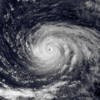



- …that the Joint Typhoon Warning Center considers that Typhoon Vera (pictured) of 1986 is actually two distinct systems, formed from two separated low-level circulations?
- …that Cyclone Freddy (track pictured) in 2023 was the longest-lasting tropical cyclone worldwide?
- …that Cyclone Raquel (track pictured) travelled between the Australian and South Pacific basins between the 2014–15 and 2015–16 seasons, spanning both seasons in both basins?
- …that Hurricane Otis (pictured) in 2023 was the first Pacific hurricane to make landfall at Category 5 intensity and surpassed Hurricane Patricia as the strongest landfalling Pacific hurricane on record?
General images -

The 1990–91 South Pacific cyclone season was a below-average season; only two tropical cyclones occurred within the South Pacific to the east of 160°E. The season officially ran from November 1, 1990, to April 30, 1991, but the first disturbance of the season formed on November 23 and the last dissipated on May 19. This is the period of the year when most tropical cyclones form within the South Pacific Ocean. During the season, no one was killed from tropical disturbances within the South Pacific. However, six people were killed by Cyclone Joy when it made landfall on Australia. The only tropical cyclone to cause any damage while within this basin was Sina, which caused at least $18.5 million (1991 USD) worth of damage to Fiji and Tonga. As a result of the impacts of both Joy and Sina, the names were retired from the tropical cyclone naming lists.
Within the South Pacific, tropical cyclones were monitored by the Tropical Cyclone Warning Centers (TCWC) at the Fiji Meteorological Service in Nadi and by the Meteorological Service of New Zealand Limited in Wellington. Tropical cyclones that moved to the west of 160°E were monitored as a part of the Australian region by the Australian Bureau of Meteorology. Both the United States Joint Typhoon Warning Center (JTWC) and the Naval Western Oceanography Center (NWOC) issued unofficial warnings within the southern Pacific. The JTWC issued warnings between 160°E and the International Date Line, while the NWOC issued warnings for tropical cyclones forming between the International Date Line and the coasts of the Americas. Both the JTWC and the NWOC-designated tropical cyclones with a number and a P suffix with numbers assigned in numerical order to tropical cyclones developing within the whole of the Southern Hemisphere. TCWC Nadi and TCWC Wellington both use the Australian Tropical Cyclone Intensity Scale, and measure windspeeds over ten minutes, while the JTWC and the NWOC measured sustained winds over one minute and use the Saffir–Simpson Hurricane Scale. (Full article...)
Topics
Subcategories
Related WikiProjects
WikiProject Tropical cyclones is the central point of coordination for Wikipedia's coverage of tropical cyclones. Feel free to help!
WikiProject Weather is the main center point of coordination for Wikipedia's coverage of meteorology in general, and the parent project of WikiProject Tropical cyclones. Three other branches of WikiProject Weather in particular share significant overlaps with WikiProject Tropical cyclones:
- The Non-tropical storms task force coordinates most of Wikipedia's coverage on extratropical cyclones, which tropical cyclones often transition into near the end of their lifespan.
- The Floods task force takes on the scope of flooding events all over the world, with rainfall from tropical cyclones a significant factor in many of them.
- WikiProject Severe weather documents the effects of extreme weather such as tornadoes, which landfalling tropical cyclones can produce.
Things you can do
 |
Here are some tasks awaiting attention:
|
Wikimedia
The following Wikimedia Foundation sister projects provide more on this subject:
-
Commons
Free media repository -
Wikibooks
Free textbooks and manuals -
Wikidata
Free knowledge base -
Wikinews
Free-content news -
Wikiquote
Collection of quotations -
Wikisource
Free-content library -
Wikiversity
Free learning tools -
Wikivoyage
Free travel guide -
Wiktionary
Dictionary and thesaurus






